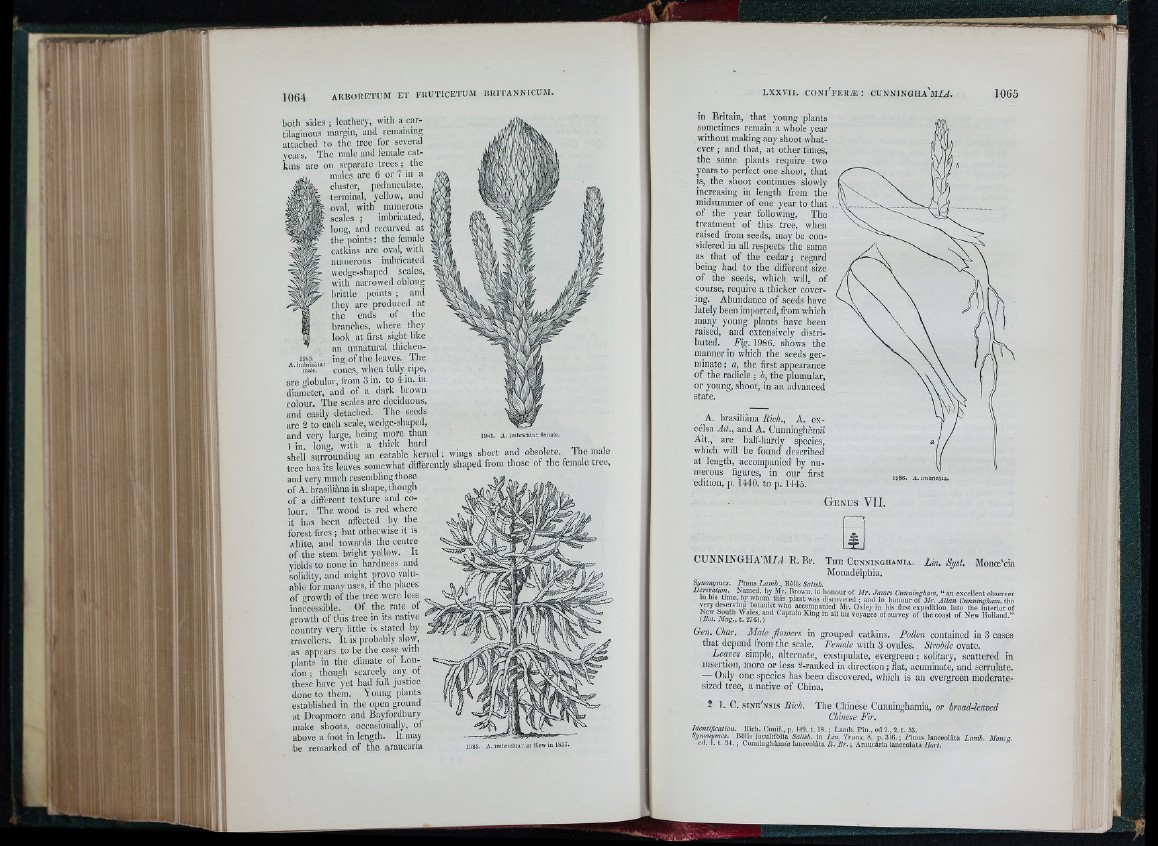
both sides ; leatliery, witli a cartilaginous
margin, and remaining
attached to the tree for several
years. The male and female catkins
are on sepiu-ate trees i the
males are C or 7 in a
cluster, pedunculate,
terminal, yellow, and
oval, with numerous
scales ; imbricated,
‘ long, and recurved at
the points : the female
catkins are oval, with
luimerofis imbricated
wedge-shaped scales, ■
with narrowed oblong
brittle points ; and
they are produced at
the ends of the
branches, where they
look at first sight like
an unnatural thicken-
I9S3. ing of the leaves. The
cories, when fully ripe,
are globular, from 3 in. to 4 in. in
diameter, and of a dark brown
colour. The scales are deciduous,
and easily detached. The seeds
are 2 to each scale, wedge-shaped,
and very large, being more than
1 in. long, with a thick hard , , , ,,,, ,
shell surrounding an eatable kernel: wings short and obsolete. Ih e male
tree has its leaves somewhat difierently shaped from those of the female treo,
and very much resembling those
of A. brasiliana in shape, though
of a different texture and colour.
The wood is red where
it has been affected by the
forest fires ; but otherwise it is
xhite, and towards the centre
of the stem bright yellow. It
yields to none in hardness and
solidity, and might prove valuable
for many uses, if the places
of growth oi' the tree were less ,
inaccessible. Of the rate of
growth of this tree in its native
country very little is stated by
travellers. It is probably slow,
as appears to be the case with
plants in the climate of London
; though scarcely any of
19S4. A. im b ric à ta : female.
these have yet had full justice
done to them. Young plants
established in the open ground
at Dropmore and Bayfordbury
make shoots, occasionally, of
above a foot in length. It may
he remarked of the araucaria idbs. a. imteioua .■ at Ke* m is37.
in Britain, that young plants
sometimes remain a wliole year
without making any shoot whatever
; and that, at other times,
the same plants require two
years to perfect one shoot, that
is, the shoot continues slowly
increasing in length from the
midsummer of one year to that
of the year following. The
treatment of this tree, when
raised from seeds, may be considered
in all respects the same
as that of the cedar ; regard
being had to the different size
of the seeds, which will, of
course, require a thicker covering.
Abundance of seeds have
lately been imported, from which
many young plants have been
raised, and extensively distributed.
Fig. 1986. shows the
manner in which the seeds germinate
; a, the first appearance
o f the radicle j b, the plumular,
or young, shoot, in an advanced
state.
A. bra.siliàna A. excelsa
AU., and A. Cunningham«
Ait., are half-hardy species,
which will be found described
at length, accompanied by numerous
figures, in our first
edition, p. Ì440. to p. 1445.
G e n u s VII.
CUNNINGHA'MJlÌ R. Br. T h e C u n n i n g i i a m i a . Lin. Syst. Monoe'cia
Monadélphia.
Synonymes. P in u s Lamb., Bèlis Salisb.
Derivation. Named, by Mr. Brown, in honour of Mr. James Cunningham., “ an excellent observer
in Jiis time, by whom_ this plant was discovered ; and in honour of Mr. Allan Cunningham, the
very deserving botanist who accompanied Mr. Oxieyin his first expedition into the mterior of
fp o t Mag t^2743 ^ voyages of survey of the coast of New Holland.”
Gen. Char. Male fioiuers in grouped catkins. Pollen contained in 3 cases
that depend from the scale. Female with 3 ovules. Strobile ovate.
Leaves simple, alternate, exstipulate, evergreen ; solitary, scattered in
insertion, more or less 2-ranked in direction ; flat, acuminate, and serrulate.
— Only one .species has been discovered, which is an evergreen moderatesized
tree, a native of China.
Î I. C. s i n e 'n s i s Rich. The Chinese Cunninghamia, or broad-leaved
Chinese Fir.
Identification. Rich. Conif., p. 149. t. 18. ; Lamb. Pin., cd 2., 2. t. 53.
Synonymes. Bèlis jaculifòlia Salisb. in L in. Trans. 8. p. 316. ; Pin u s lanceolàta Lamb. Moncg.
ed. 1. t. 34. ; Cunninghàm/a lanceolàta I{. Br. ; Aruucària lanceolàta Ilort.